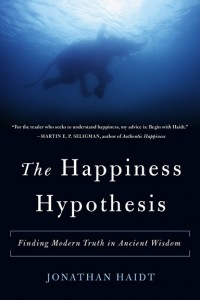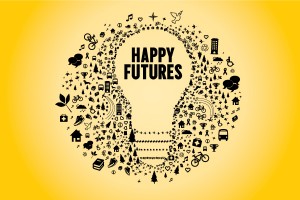The theme of Happiness has been popping up (like popcorn!) in the last while. In his most basic teachings the Dalai Lama says, ” All human beings are the same. “We all want happiness and do not want suffering.”
Well yes, we might say, but what is happiness, where does it come from…We can’t buy it, but how do we “get” it? What do we know about its opposites, suffering, stress, tension…
Many authors and experts in many fields have pondered these questions and put out suggestions, programs, best-selling books. Following I share a few that have come my way. A full survey would be a PhD thesis, or several…so this is just a sampler! May it spark or invite reflection and sharing about the balance and sources of happiness and its opposites in your life.
My women’s group, The Web :-), read The Happiness Project a  while ago. Gretchen Rubin’s year long experiment is fascinating, and offers insights and suggestions as we follow her through the months. Having more fun is one thing that resonated with me 🙂 I Keep forgetting, as I tend to be pretty serious, not to say driven. Laughing in the morning, lightening up as I cut fruit, taking the breath of appreciation as I’m cycling to an appointment…
while ago. Gretchen Rubin’s year long experiment is fascinating, and offers insights and suggestions as we follow her through the months. Having more fun is one thing that resonated with me 🙂 I Keep forgetting, as I tend to be pretty serious, not to say driven. Laughing in the morning, lightening up as I cut fruit, taking the breath of appreciation as I’m cycling to an appointment…
In the Diamond Approach, there is a teaching called the Markabah, which explores our existence as the very essence of pure pleasure! There’s mindfulness, yes, but actually dropping in to feel the pleasure, the enjoyment, the fun of regular activities can be a game changer, I find.
 The Happiness Hypothesis by Jonathan Haidt was an eye opener for me. Haidt takes 10 ideas about human happiness, found throughout the world’s civilizations, religious and cultural traditions, and examines each in the light of what we know from scientific research.
The Happiness Hypothesis by Jonathan Haidt was an eye opener for me. Haidt takes 10 ideas about human happiness, found throughout the world’s civilizations, religious and cultural traditions, and examines each in the light of what we know from scientific research.
Get a load of that elephant, swimming along under water with a tiny human driver riding on top. Our cognitive capacities are the rider, and we think that’s what in charge. Well, guess again! It’s our programming, our instincts, our habits — represented by the elephant, that actually move us along. And most of that is largely unconscious — under water, so to speak.
It’s like a treasure hunt to delve into those deep recesses (with compassion and curiosity of course! not self-recrimination or super ego attacks), and discover some of the beliefs and patterns that shape and color our view of the world, our lives, our interactions. Carl Jung and others call it Shadow work… Anger and tension have been up for me recently. See Beyond Popcorn for a recent “pop” of personal insight 🙂
Another intriguing study is to be found in Happy City, a book by  Charles Montgomery, a Vancouverite, it turns out. “The message is as surprising as it is hopeful: by retrofitting our cities for happiness, we can tackle the urgent challenges of our age. The happy city, the green city, and the low-carbon city are the same place, and we can all help build it.”
Charles Montgomery, a Vancouverite, it turns out. “The message is as surprising as it is hopeful: by retrofitting our cities for happiness, we can tackle the urgent challenges of our age. The happy city, the green city, and the low-carbon city are the same place, and we can all help build it.”
One of the key components of happiness is connectedness… our ties and chances for ongoing interactions with others… isolation is a pretty sure way to spiral down, for most people. That’s one of the things I enjoy about living in an apartment building. We have community built in, if we cultivate it.
 Recently I attended a seminar called Happy Futures: Imagination and Sustainability, held at the Museum of Vancouver. It offered a rich diversity of ways we can use our creative capacities, tools for social innovation, storytelling and experiential design, to make the world a better place — for us, for our communities, for the planet.
Recently I attended a seminar called Happy Futures: Imagination and Sustainability, held at the Museum of Vancouver. It offered a rich diversity of ways we can use our creative capacities, tools for social innovation, storytelling and experiential design, to make the world a better place — for us, for our communities, for the planet.
One take away for me: in our education, we teach history, local, national, but it’s all about the past… (Nothing wrong with that, I just wish we were better at taking the lessons from the past!) But we spend no time teaching our young people, or ourselves, how to think creatively, or act imaginatively and collaboratively, about the future.
The kicker is that the future takes shape out of what we focus on, dream about, plan, take action toward. The future is not set in stone. It is evolving, along with our consciousness! It behooves us to start dreaming, imagining, future pacing — envisioning what kind of world, city, community we want to have in 20, 50 years, and working backward to see what steps we need to take NOW in order for this to happen.
Much food for reflection, hope, attention, soul and spirit, and action — toward our own personal happiness, and to the benefit of all! As always, your observations, quesitons, and forwards are most welcome!
Jill Schroder is the author of BECOMING: Journeying Toward Authenticity. BECOMING is an invitation for self-reflection, and to mine our memorable moments for insights, meaning, and growth. Check the website for a sample chapter, or see the reviews to get a flavor for the volume. Follow me on Twitter, let’s be friends on Facebook ![]()


